Lizards have become a familiar part of Hawai‘i’s landscapes, from lush gardens to city walls. Although none are native to the islands, these reptiles have adapted remarkably well to the tropical environment.
Over the years, species such as geckos, anoles, and even chameleons have been introduced, either intentionally or by accident. Today, they play an active role in controlling insects and adding to the region’s biodiversity.
Some lizards stand out for their vivid colors, unique behaviors, or fascinating adaptations. Learning about the different types of lizards in Hawai‘i helps us better understand their impact on the islands’ ecosystems.
Different Types of Lizards Found in Hawaii
Gold Dust Day Gecko (Phelsuma laticauda)
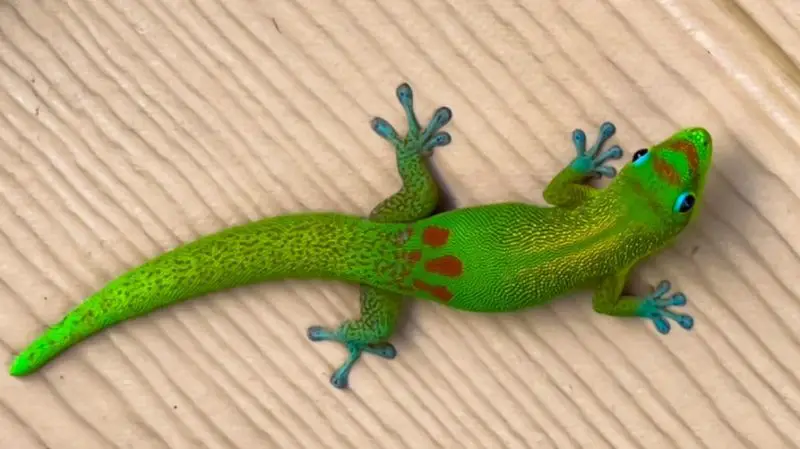
The Gold Dust Day Gecko is one of the most colorful lizards found in Hawai‘i. Native to Madagascar, it was introduced to the islands and has since thrived in warm, tropical conditions. Its bright green body, speckled with golden spots and a distinctive red stripe across the snout, makes it one of the easiest reptiles to recognize. Unlike many other lizards, this species is diurnal, meaning it is most active during the day.
This gecko feeds on a varied diet that includes insects, nectar, and fruit. In Hawai‘i, it is often seen climbing walls, trees, and even houses in search of food. Its sticky toe pads allow it to cling to smooth surfaces with ease, making it a common sight in urban areas as well as gardens and forests.
Socially, Gold Dust Day Geckos are territorial creatures. Males will defend their space aggressively against rivals, using visual displays and sometimes physical combat. They are also vocal, producing chirping or clicking sounds to communicate with others.
In Hawai‘i, they are not considered harmful but can outcompete native insects and smaller gecko species for resources. Their vibrant appearance, however, has made them a favorite among residents and visitors, often spotted basking in the sunshine.
Madagascar Giant Day Gecko (Phelsuma grandis)
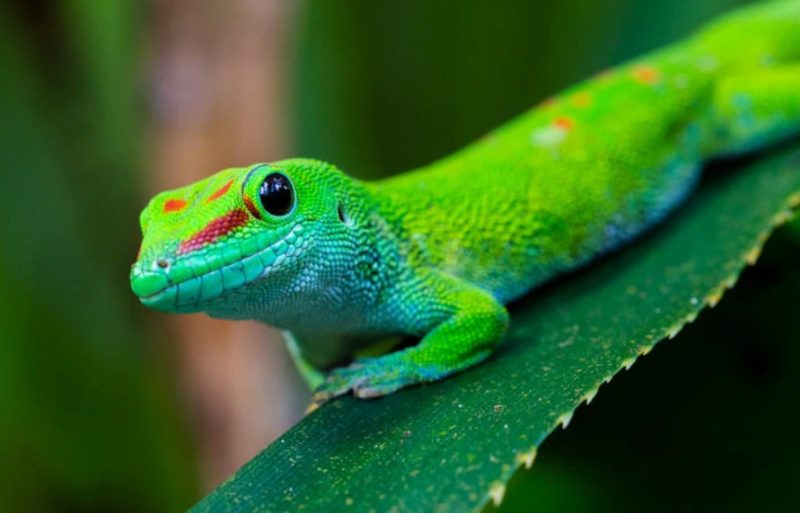
The Madagascar Giant Day Gecko is among the largest gecko species introduced to Hawai‘i. Adults can reach up to 12 inches in length, dwarfing most other lizards on the islands. With its vivid green coloration and striking red markings, it is both an impressive and beautiful species. Its size and bright colors make it stand out against tropical foliage.
This species is highly adaptable, living in both wild and urban settings. In Hawai‘i, it can be found on walls, trees, and roofs, often basking in the sun. Its climbing ability is exceptional, thanks to strong toe pads that allow it to move across vertical and even inverted surfaces.
Its diet consists primarily of insects, but it also enjoys fruit and nectar. This combination of carnivorous and frugivorous feeding habits enables it to survive in a variety of environments. In urban gardens, they are frequently observed feeding on ripe bananas, papayas, or sugary residues left outdoors.
Because of its large size, the Madagascar Giant Day Gecko can dominate areas and outcompete smaller gecko species. While not aggressive toward humans, it may occasionally bite if handled. Still, it is admired for its exotic beauty and is often photographed by curious observers.
Common House Gecko (Hemidactylus frenatus)
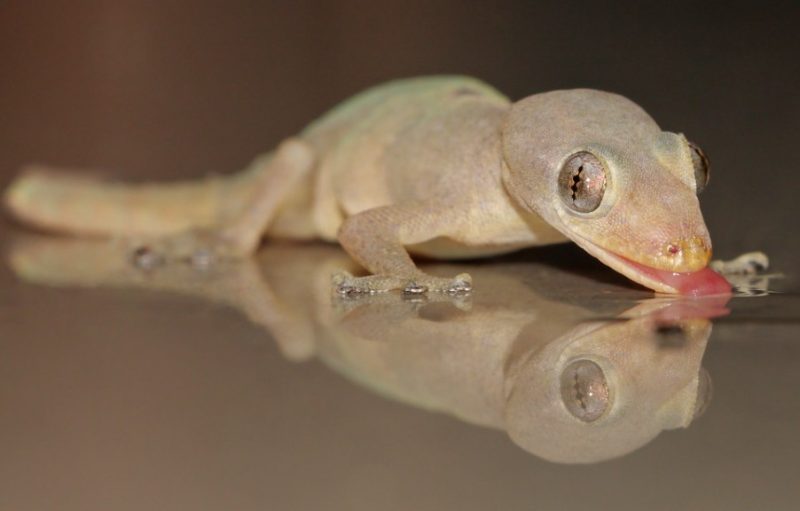
The Common House Gecko is one of the most widespread reptiles in Hawai‘i. Small, slender, and usually pale brown or gray, it is nocturnal and thrives in human-inhabited areas. At night, these geckos are often seen clinging to walls or ceilings near light sources, hunting insects attracted by the glow.
Their adaptability has allowed them to spread across tropical and subtropical regions worldwide. In Hawai‘i, they are frequently found inside homes, garages, and restaurants. Unlike day geckos, they prefer to remain hidden during the day and only emerge when darkness falls.
The Common House Gecko is a skilled insect hunter, feeding on moths, mosquitoes, and small beetles. This makes them beneficial to humans as natural pest controllers. Their ability to reproduce quickly ensures their population remains stable, even in areas with competition from other lizards.
Although plain in appearance compared to the colorful day geckos, the Common House Gecko plays an important ecological role. Its nocturnal habits, quiet chirps, and habit of lurking around lights make it a familiar presence in Hawaiian households.
Indo-Pacific Gecko (Hemidactylus garnotii)
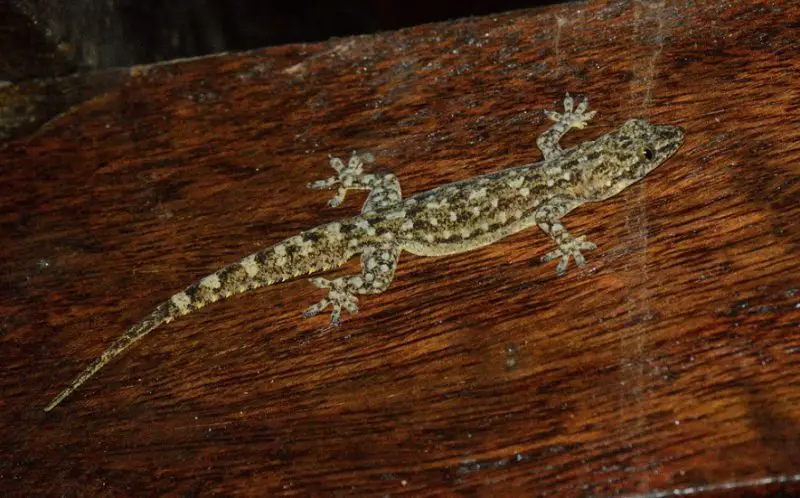
The Indo-Pacific Gecko, also known as the Garnot’s Gecko, is a parthenogenetic species, meaning it reproduces without males. All individuals are female, and they clone themselves to maintain populations. This unique trait has allowed the species to spread successfully across Hawai‘i and many other tropical islands.
It is typically light brown or gray with a smooth, somewhat shiny body. At night, these geckos are commonly seen on walls or tree trunks, blending into their surroundings. Unlike the house gecko, they tend to be more secretive and are less likely to be seen near bright lights.
Their diet is primarily insect-based, with a preference for small arthropods. Their nocturnal nature ensures that they hunt under the cover of darkness, often going unnoticed by humans. They also compete with other gecko species for food, but their ability to reproduce without males gives them a survival advantage.
In Hawai‘i, Indo-Pacific Geckos have adapted well to urban and forested environments. While not as conspicuous as the house gecko or colorful day geckos, they remain a significant part of the island’s reptile community, quietly thriving in the background.
Mourning Gecko (Lepidodactylus lugubris)
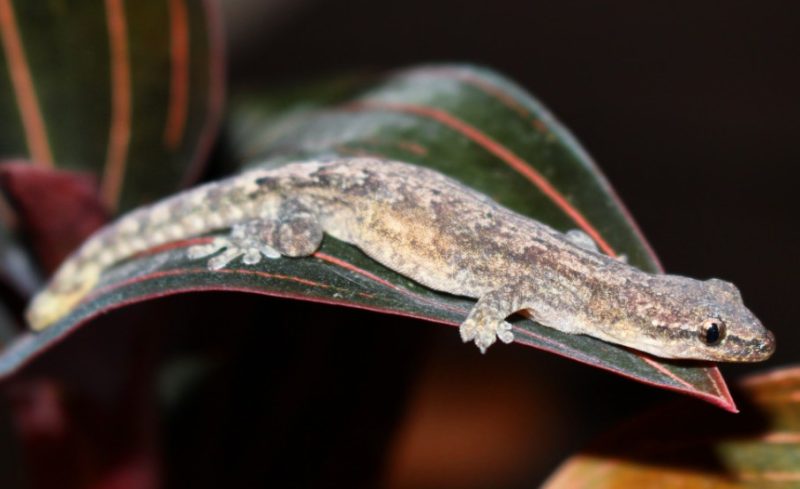
The Mourning Gecko is another parthenogenetic species found in Hawai‘i, meaning populations consist entirely of females. They are small, slender lizards that usually measure about 3.5–4 inches in length. Their name comes from the faint, mournful chirping sounds they produce, which distinguish them from other gecko species.
These geckos are nocturnal and can often be seen on walls, ceilings, and vegetation after dark. Their coloration ranges from light brown to tan, with darker markings that help them camouflage against tree bark or stone surfaces. During the day, they hide in cracks, crevices, or under leaf litter.
Mourning Geckos feed on small insects and nectar. In urban environments, they often take advantage of artificial lights that attract moths and other prey. Their diet also allows them to coexist with day geckos, though competition for resources can occur.
In Hawai‘i, the Mourning Gecko is considered harmless and relatively shy. Its ability to reproduce without males ensures its survival, and while it may not be as flashy as some introduced gecko species, it plays a quiet but steady role in the island ecosystem.
Stump-Toed Gecko (Gehyra mutilata)
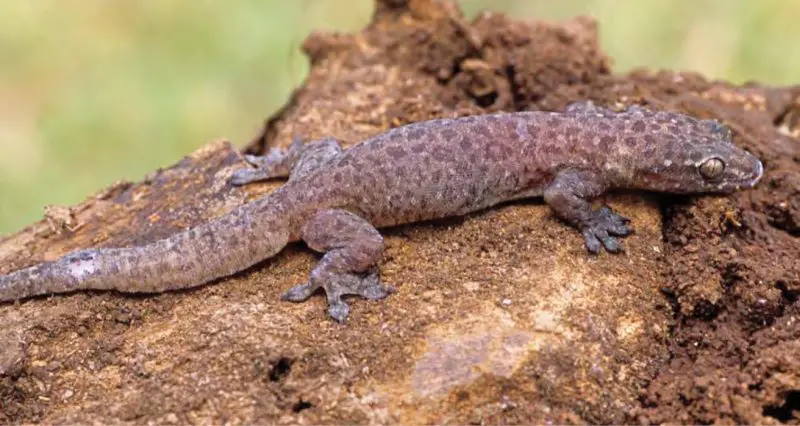
The Stump-Toed Gecko, also called the Four-Clawed Gecko, is a medium-sized lizard commonly found in Hawai‘i. It has a translucent, pale gray body with a slightly pinkish hue, making its internal organs sometimes faintly visible under strong light. Its toes appear blunt or “stump-like,” which gives this species its common name. Unlike the bright day geckos, it is more subdued in appearance but still easy to recognize once noticed.
This gecko is nocturnal and prefers to stay hidden during the day. At night, it ventures out to feed, often sticking close to human dwellings where insects are plentiful. Like many gecko species, it thrives around lights that attract moths and other prey. Its strong climbing abilities allow it to cling to smooth walls and ceilings with ease.
The Stump-Toed Gecko is primarily insectivorous, feeding on small insects and spiders. It does not compete aggressively with other gecko species but coexists in the same environments. Its quiet and discreet behavior makes it less conspicuous compared to the more territorial day geckos.
In Hawai‘i, the Stump-Toed Gecko is widespread in both urban and rural areas. While it may not be as colorful as other species, it plays an important role in controlling insect populations and is a familiar nighttime presence across the islands.
Orange-Spotted Day Gecko (Phelsuma guimbeaui)
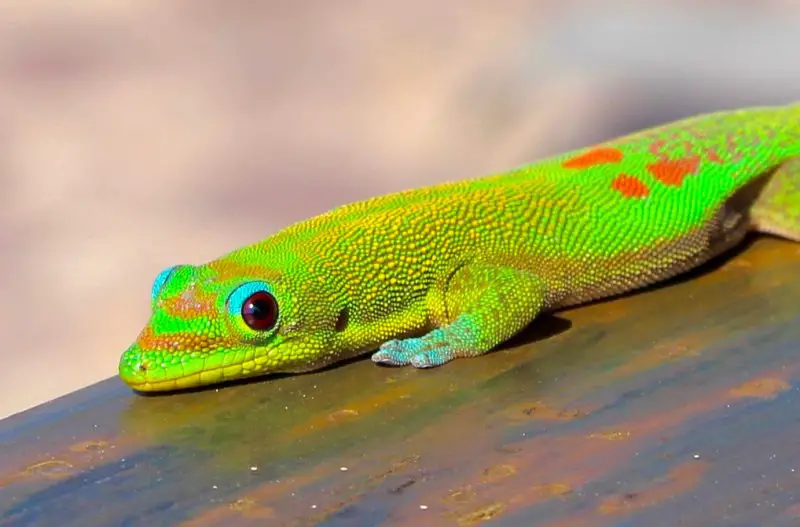
The Orange-Spotted Day Gecko is a smaller member of the day gecko family, known for its vivid green coloration dotted with bright orange or red spots. Its slender body and smooth scales give it a polished appearance, while its large, expressive eyes help it hunt during the day. Originally from Mauritius, it has adapted well to Hawai‘i’s tropical environment.
This gecko is diurnal and can often be seen basking in the sun on tree trunks, fences, and walls. Unlike nocturnal geckos, it relies on daylight to hunt and interact with its surroundings. Its bright colors serve both as camouflage among green leaves and as a warning display to rivals.
The Orange-Spotted Day Gecko feeds on insects, nectar, and soft fruits. In Hawai‘i, it is frequently observed sipping nectar from flowers, playing a small but beneficial role in pollination. Its active daytime lifestyle makes it one of the more noticeable lizards for residents and visitors.
Although not as large as the Madagascar Giant Day Gecko, it is still competitive and territorial. Males defend their areas vigorously against intruders. In Hawai‘i, their presence adds to the diversity of geckos, offering a striking splash of color in gardens and natural areas.
Green Anole (Anolis carolinensis)
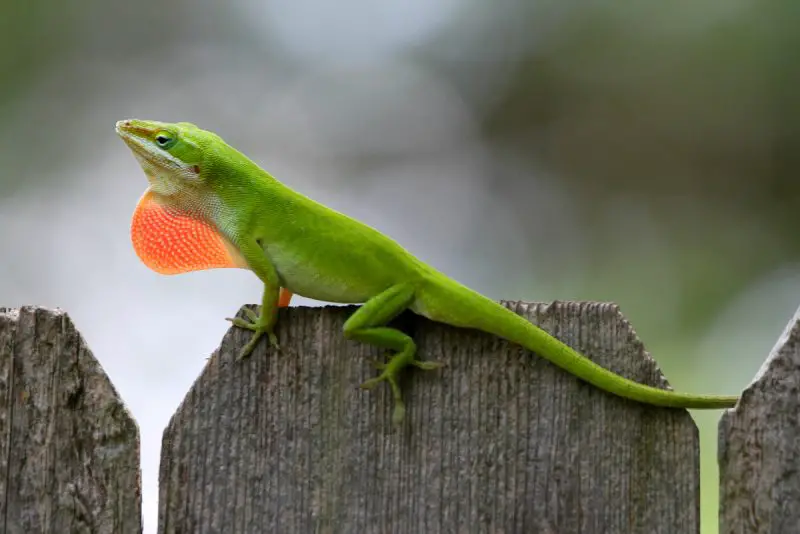
The Green Anole is one of the most striking lizards in Hawai‘i, thanks to its ability to change color from bright green to brown depending on temperature, mood, and environment. Sometimes mistaken for a chameleon, this small lizard can grow up to 8 inches long and is easily identified by its slender body and pointed snout. Males also display a pink throat fan, or dewlap, to attract mates and establish territory.
Active during the day, Green Anoles are frequently spotted on shrubs, trees, and even fences in gardens. They are excellent climbers and use their agility to chase insects or escape predators. When threatened, they may puff out their dewlap or change color to blend in with their surroundings.
Their diet consists mainly of insects such as flies, moths, and beetles. By preying on these insects, they help keep local pest populations in check. They prefer sunny areas with plenty of vegetation but can adapt to urban spaces as well.
In Hawai‘i, the Green Anole is well established and widely distributed across the islands. While they coexist with other introduced lizards, their ability to change color and their bold displays make them one of the most noticeable reptiles in the region.
Brown Anole (Anolis sagrei)

The Brown Anole is another introduced lizard species in Hawai‘i, originally from the Caribbean. It is smaller and stockier than the Green Anole, with a brown or gray body often patterned with stripes or spots. Unlike its green relative, the Brown Anole cannot turn bright green, though it may shift shades of brown to better blend into its environment.
This species is highly adaptable and tends to live closer to the ground. It can often be found darting across sidewalks, hiding in leaf litter, or basking on low walls. Brown Anoles are quick movers, using sudden bursts of speed to escape predators or chase prey.
Like the Green Anole, males of this species also display a dewlap, but theirs is typically orange-red. This signaling is used for courtship and territory defense. Brown Anoles are prolific breeders, allowing their populations to spread quickly throughout Hawai‘i.
Their diet consists of insects and small arthropods. In some cases, they may compete with Green Anoles for food and habitat. In Hawai‘i, their presence has added another layer of reptile diversity, though their rapid reproduction makes them one of the more dominant lizard species in certain areas.
Jackson’s Chameleon (Trioceros jacksonii)
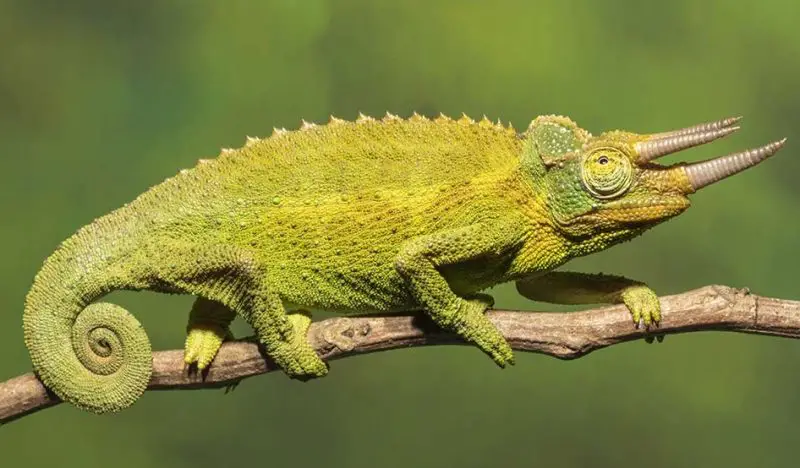
Jackson’s Chameleon is one of the most unique lizards found in Hawai‘i. Native to East Africa, it was introduced to the islands and has since formed stable populations. Males are easily identified by their three horn-like protrusions on the head, giving them a miniature triceratops appearance. Females are generally hornless or have smaller horns. Their coloration ranges from green to turquoise, and they can change shades depending on mood and environment.
Unlike the fast and agile anoles or geckos, Jackson’s Chameleons move slowly and deliberately. They rely on camouflage and their independently moving eyes to scan their surroundings. Their prehensile tails and zygodactyl feet help them grasp branches firmly, making them well adapted for life in trees and shrubs.
Their diet consists mainly of insects, but they may also consume snails and small invertebrates. Using their long, sticky tongues, they can capture prey with incredible speed and precision. This unique hunting method sets them apart from other lizards in Hawai‘i.
In Hawai‘i, Jackson’s Chameleons are considered invasive, as they may prey on native insects and compete with other reptiles. However, their unusual appearance and fascinating behaviors make them one of the most captivating lizards on the islands. They are often spotted in gardens, forests, and residential areas, blending seamlessly into the greenery.
FAQs About Lizards in Hawai‘i
Are there native lizards in Hawai‘i?
No, there are no truly native lizards in Hawai‘i. All the species found today were introduced, either accidentally or intentionally, from other parts of the world. Despite this, they have become a familiar part of the islands’ ecosystems and urban landscapes.
Are lizards in Hawai‘i dangerous to humans?
Most lizards in Hawai‘i are harmless to people. Geckos, anoles, and even Jackson’s Chameleons do not pose a threat. While some species may bite if handled, their bites are not venomous or dangerous. Instead, these reptiles play a useful role by controlling insect populations.
Why are there so many geckos in Hawai‘i?
Geckos thrive in Hawai‘i because of the warm, tropical climate and the abundance of insects. Many species also reproduce quickly, and some, like the Mourning Gecko and Indo-Pacific Gecko, do not even require males to reproduce. Human dwellings with artificial lights attract insects, which further benefits gecko populations.
What do lizards in Hawai‘i eat?
Most lizards in Hawai‘i are insectivores, feeding on flies, mosquitoes, moths, and beetles. Some species, such as day geckos and Jackson’s Chameleons, also eat nectar, fruit, or even small invertebrates like snails. Their varied diets help them adapt to both wild and urban environments.
Can you keep Hawaiian lizards as pets?
Some lizards found in Hawai‘i, such as day geckos or Jackson’s Chameleons, are popular in the pet trade worldwide. However, in Hawai‘i, strict wildlife regulations may apply. Collecting or keeping these lizards without permits can be illegal, as many are considered invasive species that impact the local ecosystem.

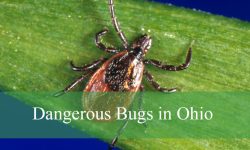
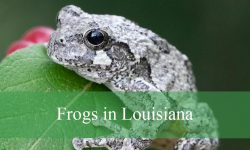


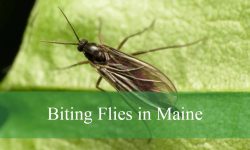
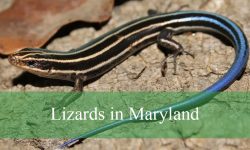
You forgot
Iguanas
Cuban anole
Tokay gecko
On Oahu
Veiled chameleon
On Maui
thanks for your updating.